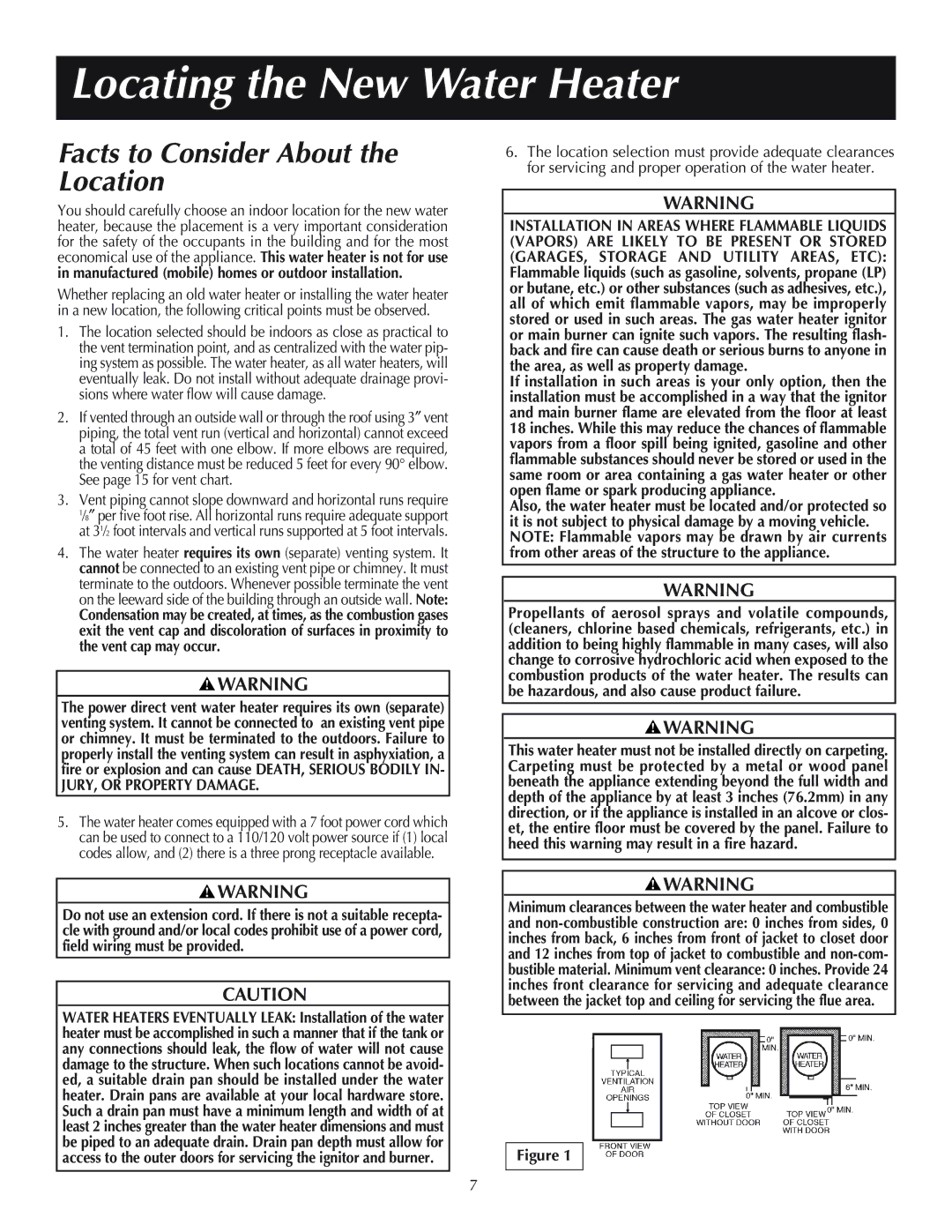
Locating the New Water Heater
Facts to Consider About the Location
You should carefully choose an indoor location for the new water heater, because the placement is a very important consideration for the safety of the occupants in the building and for the most economical use of the appliance. This water heater is not for use in manufactured (mobile) homes or outdoor installation.
Whether replacing an old water heater or installing the water heater in a new location, the following critical points must be observed.
1.The location selected should be indoors as close as practical to the vent termination point, and as centralized with the water pip- ing system as possible. The water heater, as all water heaters, will eventually leak. Do not install without adequate drainage provi- sions where water flow will cause damage.
2.If vented through an outside wall or through the roof using 3″ vent piping, the total vent run (vertical and horizontal) cannot exceed a total of 45 feet with one elbow. If more elbows are required, the venting distance must be reduced 5 feet for every 90° elbow. See page 15 for vent chart.
3.Vent piping cannot slope downward and horizontal runs require
1⁄8″ per five foot rise. All horizontal runs require adequate support at 31⁄2 foot intervals and vertical runs supported at 5 foot intervals.
4.The water heater requires its own (separate) venting system. It cannot be connected to an existing vent pipe or chimney. It must terminate to the outdoors. Whenever possible terminate the vent on the leeward side of the building through an outside wall. Note:
Condensation may be created, at times, as the combustion gases exit the vent cap and discoloration of surfaces in proximity to the vent cap may occur.
![]() WARNING
WARNING
The power direct vent water heater requires its own (separate) venting system. It cannot be connected to an existing vent pipe or chimney. It must be terminated to the outdoors. Failure to properly install the venting system can result in asphyxiation, a fire or explosion and can cause DEATH, SERIOUS BODILY IN-
JURY, OR PROPERTY DAMAGE.
5.The water heater comes equipped with a 7 foot power cord which can be used to connect to a 110/120 volt power source if (1) local codes allow, and (2) there is a three prong receptacle available.
6.The location selection must provide adequate clearances for servicing and proper operation of the water heater.
![]() WARNING
WARNING
INSTALLATION IN AREAS WHERE FLAMMABLE LIQUIDS (VAPORS) ARE LIKELY TO BE PRESENT OR STORED (GARAGES, STORAGE AND UTILITY AREAS, ETC): Flammable liquids (such as gasoline, solvents, propane (LP) or butane, etc.) or other substances (such as adhesives, etc.), all of which emit flammable vapors, may be improperly stored or used in such areas. The gas water heater ignitor or main burner can ignite such vapors. The resulting flash- back and fire can cause death or serious burns to anyone in the area, as well as property damage.
If installation in such areas is your only option, then the installation must be accomplished in a way that the ignitor and main burner flame are elevated from the floor at least 18 inches. While this may reduce the chances of flammable vapors from a floor spill being ignited, gasoline and other flammable substances should never be stored or used in the same room or area containing a gas water heater or other open flame or spark producing appliance.
Also, the water heater must be located and/or protected so it is not subject to physical damage by a moving vehicle. NOTE: Flammable vapors may be drawn by air currents from other areas of the structure to the appliance.
![]() WARNING
WARNING
Propellants of aerosol sprays and volatile compounds, (cleaners, chlorine based chemicals, refrigerants, etc.) in addition to being highly flammable in many cases, will also change to corrosive hydrochloric acid when exposed to the combustion products of the water heater. The results can be hazardous, and also cause product failure.
![]() WARNING
WARNING
This water heater must not be installed directly on carpeting. Carpeting must be protected by a metal or wood panel beneath the appliance extending beyond the full width and depth of the appliance by at least 3 inches (76.2mm) in any direction, or if the appliance is installed in an alcove or clos- et, the entire floor must be covered by the panel. Failure to heed this warning may result in a fire hazard.
![]() WARNING
WARNING
Do not use an extension cord. If there is not a suitable recepta- cle with ground and/or local codes prohibit use of a power cord, field wiring must be provided.
![]() CAUTION
CAUTION
WATER HEATERS EVENTUALLY LEAK: Installation of the water heater must be accomplished in such a manner that if the tank or any connections should leak, the flow of water will not cause damage to the structure. When such locations cannot be avoid- ed, a suitable drain pan should be installed under the water heater. Drain pans are available at your local hardware store. Such a drain pan must have a minimum length and width of at least 2 inches greater than the water heater dimensions and must be piped to an adequate drain. Drain pan depth must allow for access to the outer doors for servicing the ignitor and burner.
![]() WARNING
WARNING
Minimum clearances between the water heater and combustible and
Figure 1
7
